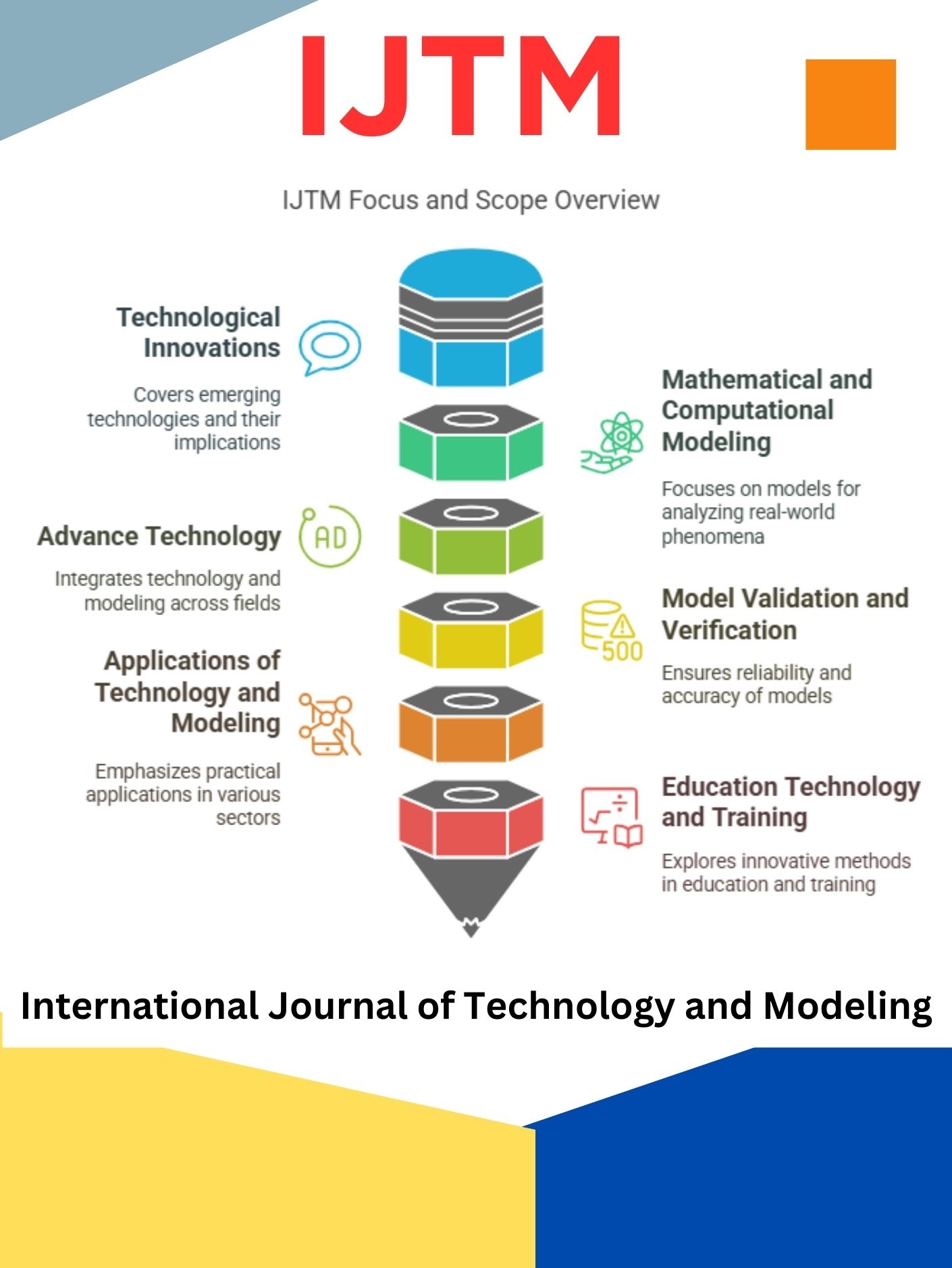Population Dynamics Modeling with Differential Equation Method
DOI:
https://doi.org/10.63876/ijtm.v1i3.107Keywords:
Population dynamics modeling, differential equations, population growth, interpopulation interactions, numerical simulationsAbstract
Population dynamics modeling is one of the important approaches in understanding population development and its influence on various aspects of life, such as economic, social, and environmental. This article discusses the application of differential equation methods in modeling population dynamics, with a focus on the analysis of growth and interactions between populations. The models used include exponential growth models, logistics, and the Lotka-Volterra model to describe competitive interactions and predations between populations. Through numerical simulations and qualitative analysis, this article shows how parameters such as birth rate, mortality, and environmental carrying capacity affect population growth patterns. In addition, the influence of external factors such as government policies and natural disasters is also incorporated into the model to expand the application in real contexts. The results of the analysis show that the differential equation model is able to provide an accurate picture of population dynamics if the parameters are estimated correctly. This article also highlights the importance of model validation using empirical data to ensure prediction reliability. This modeling can be used as a tool in development planning, resource allocation, and risk mitigation in various sectors. The conclusion of this study is that the differential equation method is not only effective in explaining population phenomena, but also flexible to adapt to various dynamic conditions. As such, this approach offers a significant contribution to demographic studies and data-driven decision-making.
Downloads
References
L. De Cubber, S. Lefebvre, T. Lancelot, D. S. F. Jorge, and S. M. Gaudron, “Unravelling mechanisms behind population dynamics, biological traits and latitudinal distribution in two benthic ecosystem engineers: A modelling approach,” Prog. Oceanogr., vol. 219, p. 103154, Dec. 2023, doi: https://doi.org/10.1016/j.pocean.2023.103154.
M. Song, X. Gong, J. Du, T. Lu, and R. J. Jiao, “Population dynamics modeling of crowdsourcing as an evolutionary Cooperation-Competition game for fulfillment capacity balancing and optimization of smart manufacturing services,” Comput. Ind. Eng., vol. 197, p. 110572, Nov. 2024, doi: https://doi.org/10.1016/j.cie.2024.110572.
G. Zeng, S. Chen, H. Wu, and M. Yang, “Continuous-discrete extended Kalman filtering based on the neural ordinary differential equations method,” Eng. Appl. Artif. Intell., vol. 133, p. 108611, Jul. 2024, doi: https://doi.org/10.1016/j.engappai.2024.108611.
S. S M, P. Kumar, and V. Govindaraj, “A neural networks-based numerical method for the generalized Caputo-type fractional differential equations,” Math. Comput. Simul., vol. 213, pp. 302–323, Nov. 2023, doi: https://doi.org/10.1016/j.matcom.2023.06.012.
G. C. Paul, Tauhida, and D. Kumar, “Revisiting Fisher-KPP model to interpret the spatial spreading of invasive cell population in biology,” Heliyon, vol. 8, no. 10, p. e10773, Oct. 2022, doi: https://doi.org/10.1016/j.heliyon.2022.e10773.
S. L. Manu and S. Shikaa, “Mathematical modeling of Taraba State population growth using exponential and logistic models,” Results Control Optim., vol. 12, p. 100265, Sep. 2023, doi: https://doi.org/10.1016/j.rico.2023.100265.
Z. Li et al., “Individual dose recommendations for drug interaction between tacrolimus and voriconazole in adult liver transplant recipients: A semiphysiologically based population pharmacokinetic modeling approach,” Eur. J. Pharm. Sci., vol. 184, p. 106405, May 2023, doi: https://doi.org/10.1016/j.ejps.2023.106405.
T. V. San Miguel, D. Da Re, and V. Andreo, “A systematic review of Aedes aegypti population dynamics models based on differential equations,” Acta Trop., vol. 260, p. 107459, Dec. 2024, doi: https://doi.org/10.1016/j.actatropica.2024.107459.
A. Shahjalal, “Validation and modification of a semi-empirical model for sound absorption by perforated liners in the absence of flow based on comparisons with data from full scale measurements,” Fuel Commun., vol. 14, p. 100087, Mar. 2023, doi: https://doi.org/10.1016/j.jfueco.2023.100087.
M. N. Maunder, “Towards a comprehensive framework for providing management advice from statistical inference using population dynamics models,” Ecol. Modell., vol. 498, p. 110836, Dec. 2024, doi: https://doi.org/10.1016/j.ecolmodel.2024.110836.
J. S. Cánovas and M. Muñoz-Guillermo, “On the dynamics of a hyperbolic–exponential model of growth with density dependence,” Commun. Nonlinear Sci. Numer. Simul., vol. 104, p. 106050, Jan. 2022, doi: https://doi.org/10.1016/j.cnsns.2021.106050.
P. Palumbo, S. Busti, and M. Vanoni, “A cell growth model accounting for both ribosomal sub-units synthesis: conditions for the exponential growth,” IFAC-PapersOnLine, vol. 56, no. 2, pp. 7240–7245, 2023, doi: https://doi.org/10.1016/j.ifacol.2023.10.332.
M. M. Islam and M. Arakawa, “Development of an integrated scenario-based stochastic rolling-planning multistage logistics model considering various risks,” Heliyon, vol. 9, no. 11, p. e22289, Nov. 2023, doi: https://doi.org/10.1016/j.heliyon.2023.e22289.
U. N. Gogoi, P. Saikia, L. Devi, L. Khataniar, and D. J. Mahanta, “Rapid parameter estimation of modified Gompertz and Logistic model for analyzing the growth of Escherichia Coli K2,” Int. J. Thermofluids, vol. 24, p. 100851, Nov. 2024, doi: https://doi.org/10.1016/j.ijft.2024.100851.
A. V. Platonov, “Analysis of the dynamical behavior of solutions for a class of hybrid generalized Lotka–Volterra models,” Commun. Nonlinear Sci. Numer. Simul., vol. 119, p. 107068, May 2023, doi: https://doi.org/10.1016/j.cnsns.2022.107068.
A. L. A. de Araujo, A. C. Fassoni, K. F. L. Madalena, and L. F. Salvino, “Analysis and simulation of an integro-differential Lotka–Volterra model with variable reproduction rates and optimal control,” Commun. Nonlinear Sci. Numer. Simul., vol. 134, p. 108000, Jul. 2024, doi: https://doi.org/10.1016/j.cnsns.2024.108000.
R. Nuca, E. Storvik, F. A. Radu, and M. Icardi, “Splitting schemes for coupled differential equations: Block Schur-based approaches & Partial Jacobi approximation,” Comput. Math. with Appl., vol. 161, pp. 190–201, May 2024, doi: https://doi.org/10.1016/j.camwa.2024.02.042.
T. V. Gortsas, S. V. Tsinopoulos, and D. Polyzos, “A local domain boundary element method for solving the nonlinear fisher KPP diffusion-reaction equation,” Eng. Anal. Bound. Elem., vol. 138, pp. 177–188, May 2022, doi: https://doi.org/10.1016/j.enganabound.2022.02.008.
B. Castillo, M. T. Muñoz-Quezada, and C. Sapiente-Aguirre, “Demographics and tenure of the Chilean urban dog population. A mathematical model,” Prev. Vet. Med., vol. 225, p. 106141, Apr. 2024, doi: https://doi.org/10.1016/j.prevetmed.2024.106141.
I. Ghosh, M. M. Rashid, and S. Mawa, “An evaluation of multispecies population dynamics models through numerical simulations using the new iterative method,” Healthc. Anal., vol. 4, p. 100283, Dec. 2023, doi: https://doi.org/10.1016/j.health.2023.100283.
M. Mahbub and R. M. Shubair, “Contemporary advances in multi-access edge computing: A survey of fundamentals, architecture, technologies, deployment cases, security, challenges, and directions,” J. Netw. Comput. Appl., vol. 219, p. 103726, Oct. 2023, doi: https://doi.org/10.1016/j.jnca.2023.103726.



